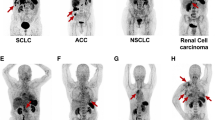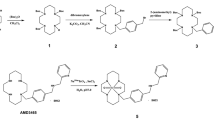Abstract
Purpose
Noninvasive quantification of chemokine receptor 4 (CXCR4) expression could serve as a prognostic indicator and may be of value for the design of personalized therapies and posttreatment monitoring. The objective of the present study was to assess the use of 99mTc-radiolabeled small-interference RNA (siRNA) targeting CXCR4 to detect CXCR4 expression in vivo.
Procedures
CXCR4 siRNAs were radiolabeled with 99mTc using the bifunctional chelator hydrazinonicotinamide (HYNIC), and the labeling efficiency, specific activity and radiochemical purity were determined. The stability of the probe in serum was assessed by measuring its radiochemical purity and inhibitory activity by RT-PCR and western blotting. Biodistribution studies and static imaging were performed in MDA-MB-231 tumor-bearing mice.
Results
Radiochemical purity remained highly stable in PBS and fresh human serum at room temperature and at 37 °C. Radiolabeled siRNA1 showed strong inhibitory effects similar to those of unlabeled siRNA1 on both CXCR4 messenger RNA (mRNA) and protein in vitro. The excretion of the probe occurred mainly through the liver and kidneys. Tumors were clearly visualized at 1–10 h after injection of the probe, but not after injection of the control probe.
Conclusions
99mTc-labeled CXCR4 siRNA1 shows tumor-specific accumulation and could be a promising strategy for the visualization of CXCR4 expression in human breast cancer.



Similar content being viewed by others
References
Peled A, Petit I, Kollet O et al (1999) Dependence of human stem cell engraftment and repopulation of NOD/SCID mice on CXCR4. Science 283:845–848
Dar A, Kollet O, Lapidot T (2006) Mutual, reciprocal SDF-1/CXCR4 interactions between hematopoietic and bone marrow stromal cells regulate human stem cell migration and development in NOD/SCID chimeric mice. Exp Hematol 34:967–975
Chong BF, Mohan C (2009) Targeting the CXCR4/CXCL12 axis in systemic lupus erythematosus. Expert Opin Ther Targets 13:1147–1153
Steen A, Schwartz TW, Rosenkilde MM (2009) Targeting CXCR4 in HIV cell-entry inhibition. Mini Rev Med Chem 9:1605–1621
Teicher BA, Fricker SP (2010) CXCL12 (SDF-1)/CXCR4 pathway in cancer. Clin Cancer Res 16:2927–2931
Duda DG, Kozin SV, Kirkpatrick ND et al (2011) CXCL12 (SDF1a)-CXCR4/CXCR7 pathway inhibition: an emerging sensitizer for anticancer therapies? Clin Cancer Res 17:2074–2080
Muller A, Homey B, Soto H et al (2001) Involvement of chemokine receptors in breast cancer metastasis. Nature 410:50–56
Minn AJ, Gupta GP, Siegel PM et al (2005) Genes that mediate breast cancer metastasis to lung. Nature 436:518–524
Balkwill F (2004) The significance of cancer cell expression of the chemokine receptor CXCR4. Semin Cancer Biol 14:171–179
Peled A, Wald O, Burger J (2012) Development of novel CXCR4-based therapeutics. Expert Opin Investig Drugs 21:341–353
Azab AK, Runnels JM, Pitsillides C et al (2009) CXCR4 inhibitor AMD3100 disrupts the interaction of multiple myeloma cells with the bone marrow microenvironment and enhances their sensitivity to therapy. Blood 113:4341–4351
Wong D, Korz W (2008) Translating an antagonist of chemokine receptor CXCR4: from bench to bedside. Clin Cancer Res 14:7975–7980
Burger JA, Stewart DJ (2009) CXCR4 chemokine receptor antagonists: perspectives in SCLC. Expert Opin Investig Drugs 18:481–490
Debnath B, Xu S, Grande F et al (2013) Small molecule inhibitors of CXCR4. Theranostics 3:47–75
Hanaoka H, Mukai T, Tamamura H et al (2006) Development of a 111In-labeled peptide derivative targeting a chemokine receptor, CXCR4, for imaging tumors. Nucl Med Biol 33:489–494
Nimmagadda S, Pullambhatla M, Pomper MG (2009) Immunoimaging of CXCR4 expression in brain tumor xenografts using SPECT/CT. J Nucl Med 50:1124–1130
Misra P, Lebeche D, Ly H et al (2008) Quantitation of CXCR4 expression in myocardial infarction using 99mTc-labeled SDF-1alpha. J Nucl Med 49:963–969
De Silva RA, Peyre K, Pullambhatla M et al (2011) Imaging CXCR4 expression in human cancer xenografts: evaluation of monocyclam 64Cu-AMD3465. J Nucl Med 52:986–993
Jacobson O, Weiss ID, Kiesewetter DO et al (2010) PET of tumor CXCR4 expression with 4-18F-T140. J Nucl Med 51:1796–1804
Weiss ID, Jacobson O, Kiesewetter DO et al (2011) Positron emission tomography imaging of tumors expressing the human chemokine receptor CXCR4 in mice with the use of 64Cu-AMD3100. Mol Imaging Biol 14:106–114
Gourni E, Demmer O, Schottelius M et al (2011) PET of CXCR4 expression by a 68Ga-labeled highly specific targeted contrast agent. J Nucl Med 52:1803–1810
Weiss ID, Jacobson O (2013) Molecular imaging of chemokine receptor CXCR4. Theranostics 3:76–84
Elbashir SM, Harborth J, Lendeckel W et al (2001) Duplexes of 21-nucleotide RNAs mediate RNA interference in cultured mammalian cells. Nature 411:494–498
Bogdanov AA Jr (2008) Merging molecular imaging and RNA interference: early experience in live animals. J Cell Biochem 104:1113–1123
Kang L, Wang RF, Yan P et al (2010) Noninvasive visualization of RNA delivery with 99mTc-radiolabeled small-interference RNA in tumor xenografts. J Nucl Med 51:978–986
Yiu SM, Wong PW, Lam TW et al (2005) Filtering of ineffective siRNAs and improved siRNA design tool. Bioinformatics 21:144–151
Kraynack BA, Baker BF (2006) Small interfering RNAs containing full 2’-O-methylribonucleotide-modified sense strands display Argonaute2/eIF2C2-dependent activity. RNA 12:163–176
Bramsen JB, Laursen MB, Nielsen AF et al (2009) A large-scale chemical modificationscreen identifies design rules to generate siRNAs with high activity, high stability and low toxicity. Nucleic Acids Res 37:2867–2881
Mook OR, Baas F, de Wissel MB, Fluiter K (2007) Evaluation of locked nucleic acidmodified small interfering RNA in vitro and in vivo. Mol Cancer Ther 6:833–843
Wolfrum C, Shi S, Jayaprakash KN et al (2007) Mechanisms and optimization of in vivo delivery of lipophilic siRNAs. Nat Biotechnol 25:1149–1157
Bartlett DW, Su H, Hildebrandt IJ et al (2007) Impact of tumorspecific targeting on the biodistribution and efficacy of siRNA nanoparticles measured by multimodality in vivo imaging. Proc Natl Acad Sci USA 104:15549–15554
Merkel OM, Librizzi D, Pfestroff A et al (2009) In vivo SPECT and real-time g camera imaging of biodistribution and pharmacokinetics of siRNA delivery using an optimized radiolabeling and purification procedure. Bioconjug Chem 20:174–182
van de Water FM, Boerman OC, Wouterse AC et al (2006) Intravenously administered short interfering RNA accumulates in the kidney and selectively suppresses gene function in renal proximal tubules. Drug Metab Dispos 34:1393–1397
Park SY, Kwak W, Thapa N et al (2008) Combination therapy and noninvasive imaging with a dual therapeutic vector expressing MDR1 short hairpin RNA and a sodium iodide symporter. J Nucl Med 49:1480–1488
Acknowledgments
This study was funded by the Natural Science Foundation of Heilongjiang Province (No. H2015066).
Conflict of Interest
The authors declare that they have no competing interests.
Author information
Authors and Affiliations
Corresponding author
Additional information
Peng Fu and Lin Tian contributed equally to this work.
Rights and permissions
About this article
Cite this article
Fu, P., Tian, L., Cao, X. et al. Imaging CXCR4 Expression with 99mTc-Radiolabeled Small-Interference RNA in Experimental Human Breast Cancer Xenografts. Mol Imaging Biol 18, 353–359 (2016). https://doi.org/10.1007/s11307-015-0899-4
Published:
Issue Date:
DOI: https://doi.org/10.1007/s11307-015-0899-4




